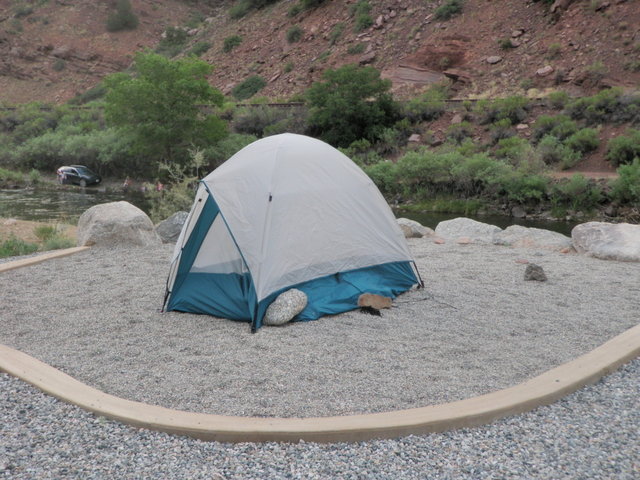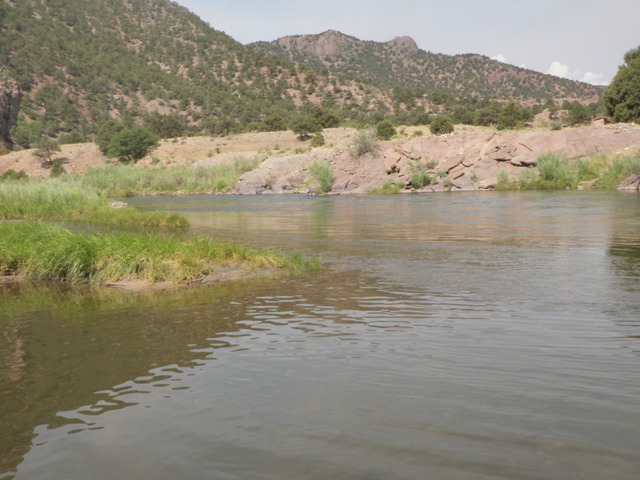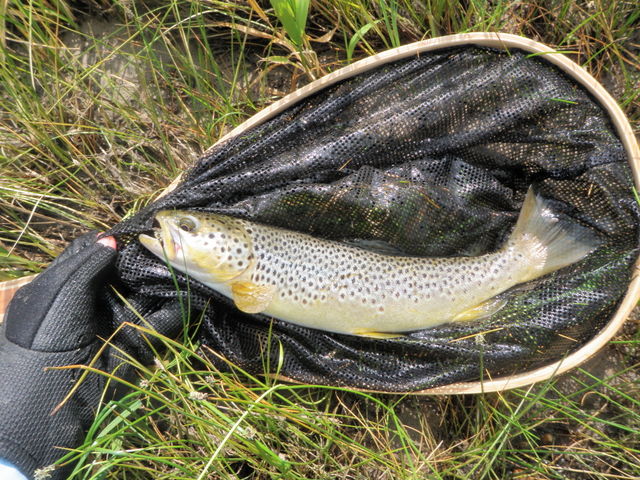Time: 8:00AM – 3:00PM
Location: Upriver from Rincon Campground
Fish Landed 15
Arkansas River 06/28/2013 Photo Album
Heat. That is what I will remember the most about my trip to the Arkansas River on June 27 and 28. It was one of the few times in my life when I was set up for some fishing, but I was too hot to actually do it.
I wrapped up the financial package for May at Saddleback Design on Wednesday so that I was in a position to go fishing on Friday and Saturday. Jane agreed to play tennis with her teammate in the summer league on Saturday morning, so Saturday was available for some fishing and I anxiously reviewed the streamflows and reports from the fly shops. Even though the snow pack was below normal in 2013, it was still much greater than 2012, and deep enough to create runoff on many Colorado Rivers. I noted that the Arkansas River had dropped to just under 700 cfs and the Eagle River was averaging around 600 cfs. I checked these first because they are freestone rivers and fish best as runoff declines and then become more difficult once they level out and resume summer flows.
I’ve experienced some success fishing the edges on the Arkansas River when the flows are up, but I was concerned that 700 was already too low for the type of fishing where the trout are all pushed to the bank to seek relief from the strong flows of the main river. The Eagle River at 600 is still a bit high and difficult to fish. The reports on the Arkansas from Royal Gorge Anglers and ArkAnglers were typically upbeat, but I checked the reports of Cutthroat Anglers in Dillon, CO, a shop that isn’t very close to either the Eagle River or the Arkansas River, and it rated the Arkansas as four stars and “on fire”. This clinched my decision and I made plans to fish the Arkansas on Friday and Saturday.
I had a dermatology appointment on Thursday morning at 8:45AM, so I planned to pack the Santa Fe afterwards and then drive to the Arkansas River below Salida and find a campsite and fish Thursday evening as well as Friday and Saturday. Unfortunately I had two biopsies taken by the dermatologist on Thursday morning thus requiring bandages, an additional complication I was not planning on. One of the spots removed was on the back of my left hand, and it was a location where a band-aid did not adhere very well.
I packed the car and was on my way by 11:15 and arrived at the first campground below Salida by 2:30PM. Unfortunately this campground was quite primitive with no fire pits or picnic tables, so I decided to move on to Rincon as I remembered this to be a more official campground. Meanwhile it was a very hot day with temperatures reaching the mid-90’s in Denver and probably the low 90’s around Salida, but I was cruising along in my air conditioned vehicle and oblivious to the heat around me. When I arrived at Rincon I quickly found an open campsite next to the river and paid for two nights, but this turned out to be a mistake. The sites were actually fairly nice although there was no shade whatsoever and the tent pad and area around the picnic table and fire pit was covered with a thick layer of gravel. This was actually quite nice for preventing tracking dirt into the tent and car, but it afforded no opportunity for driving a tent stake into the ground.
I began the task of setting up my tent in the peak late afternoon sun. Normally I can erect the REI two person tent in 15 minutes, but that would not be the case on Thursday, June 27. I forgot that the center pole of the rain fly needed to run through the center hook of the main tent, so I struggled for awhile trying to follow the directions on this step. While focusing on this last step, some strong gusts of wind began to sweep up along the river. I quickly staked out the main tent, but as I mentioned there was virtually zero penetration of the tent stakes into solid ground. A stronger gust of wind came along and tumbled the tent over a couple times and I quickly rescued it from rolling into the river. Meanwhile the bandage on the back of my hand kept sliding loose due to perspiration and all the hand movement, and I was concerned about keeping it clean and preventing infection.
There were numerous large boulders scattered about the tent pad area, so I grabbed one and tied the rope around the rock to anchor the tent instead of using the tent stake. I also threw my sleeping bag, pillow, pad and clothing bag in the tent to provide more ballast against the strong wind. Alas, even this was not enough and another gust of wind tumbled the entire tent including all my contents.
It was about this time that the occupants of the neighboring campsite arrived, and a gentleman walked over and told me that their neighbors the previous two nights had similar problems with their tent, and that explained all the boulders scattered about the tent pad. He held the tent against the relentless wind while I tossed four boulders the size of bowling balls into the tent to anchor all the corners. I then placed two more boulders on top of the outside edge of the tent on the side facing into the wind. After over an hour of frustration, my tent now withstood the steady hot wind blowing upriver, albeit with a strong lean.
At this point I was exhausted from standing in the sun and the heat and fighting the wind and stressing over how to attach the rain fly, so I set up my stool in the shade of the Santa Fe and filled my plastic cup with a large handful of ice. The water from the blue container was so warm that it melted the ice almost instantly. I drained three large 16 ounce cups of ice water while I read an article in my fishing magazine. I planned to fish after 6PM, but I was feeling extremely drowsy, so I decided to go inside the tent and lie down. After all, the tent did provide some shade from the intense sun. But as you can imagine the heat and the wind resulted in a long nap, and when I awoke, I decided to make dinner before dark and bypass evening fishing. I had positioned myself for bonus fishing time, and now I didn’t feel like taking advantage! After dinner I cleaned up the dishes and then took a walk along the river upstream from the campground. It was around 8:30 and the intense sun dropped behind the mountains to the west as I carefully observed the river. It was running high compared to my recent visits, but there were numerous attactive slack areas behind rocks and along the bank. At one point I looked down from high above and noticed a flurry of rises in a slow moving area off to the side of the strong mid-river current. I was tempted to return to the car for my fly rod and some twilight action, but it was now 8:45 and it would be nearly dark by the time I returned. In addtion accessing this area required negotiating a steep rough path from the highway down to the river. I returned to my tent and curled up between four boulders and fell asleep almost instantly.
I awoke rather early on Friday morning and a somewhat cool breeze greeted me as the sun had not yet risen above the canyon wall on the opposite side of the river. I prepared a quick breakfast and packed up all my gear and moved the Santa Fe to a parking lot at the end of the campground intended for fishermen and rafters. I did not plan to go through the windstorm again on Friday, and I called Jane to let her know that I was bailing early and would be home Friday evening after fishing.The positive to the Rincon camping experience was that I was packed up, in my waders and ready to fish by 8AM on Friday, a welcome circumstance since it was forecast to be another hot one on the Arkansas River.
I waded into the cool river next to the campground and began casting my Loomis five weight with a Pool Toy yellow hopper and a beadhead hares ear. The Loomis handles large flies better than my Sage and Orvis rods as it flexes more in the tip section and slings larger weighty flies with ease. I worked my way upstream covering the slower moving areas with three to five casts and then moving on. At some point in the first hour I hooked two fish for a split second but failed to land, and the inability to finish was due to inattentiveness on my part. Sometime between 9 and 10 I encountered a huge rock that bordered the river and forced me to circle up and around on the bank. As I descended back to a nice looking pocket along the bank in front of the large rock I was forced to make a large step down from one ledge rock to another three feet above the river. When I reached my right foot down I couldn’t touch so I had to made a small aerial drop, but as I executed this I bumped my left side against another rock and lost my balance. I felt like I was in slow motion as I tucked my right shoulder and somehow released my rod from harms way. My legs flipped around and I remember seeing their shadows against the rock wall. In an instant I landed in the water and found my footing but not before some cold river water spilled over the top of my waders. For the first time on this trip I was actually feeling cool and refreshed. I considered returning to the car for a change of clothing, but knowing the hot temperatures ahead of me, I decided to continue fishing in my wet suit and enjoy the cooling effect of the evaporation.
I moved on and encountered some nice pockets along the edge, but continued to go without any fish. I spotted a solitary golden stonefly fluttering over the water, so I exchanged the pool toy for a size 10 yellow Letort hopper, but maintained the hares ear as the dropper fly. This didn’t change my fortunes and eventually I decided to abandon the dry dropper and try a size 14 dark olive caddis. During my walk the previous evening I noticed clouds of caddis around me and swiped one from the air and discovered a dark olive body.
The dark olive caddis turned the tide and I began to catch fish at a fairly regular rate from 10:30 until around 1:30PM. The fish were in the 9-11 inch range with an occasional 12-13 incher, but I was enjoying the fairly consistent action. When I reached the area where I’d observed rises the previous evening, I landed a couple fish, but also spotted several nice size fish right along the bank that I spooked in my efforts to manuever upstream around the shrubs and rocks.
At around 12:30 I climbed the bank to circle around a large rock and a big tree and as I came down the other side I found a nice deep narrow slot along the bank between two large exposed boulders. Not wanting to scare any fish, I stopped 10 feet up the bank and flicked a cast to the edge of the slot. Wham! Immediately a trout rose and smashed the caddis, but as I tried to pressure it to bring it back upstream, the line snapped where I’d connected the tippet with a surgeon’s knot. This was the fourth dark olive caddis I’d lost during the morning, and only one remained in my frontpack, so I decided to return to the car and restock.
Upon my return from the car I continued working up along the left bank through some very juicy runs and pockets and reached eleven trout landed by 1:30. At this point I reached a nice deep run that fed into a twenty-five foot long pool, and here I began to see refusals to the caddis. At the same time I spotted a few pale morning duns drifting up from the river, so I tied on a light gray comparadun, but this also failed to produce. Next I opted for a light gray size 16 caddis, and this prompted more refusals so I moved on. I moved around a large bend in the river and found myself across from two modern day prospectors. I also noticed three or four golden stoneflies flying above the river in their lumbering bomber style, so I paused to return to the yellow Letort hopper and added a beadhead pheasant tail dropper 18 inches below the hopper. Hopefully the narrow profile of my hopper would imitate the stoneflies present, and the pheasant tail would represent the nymph stage of pale morning duns.
As I paused to reconfigure my flies, I gazed across the river to the prospectors and watched their routine. I’m sure they felt that climbing rocks along the river in the afternoon heat in waders and flailing away repeatedly was a boring activity, but what they were doing was even worse in my view. They were shoveling dirt from a bank twenty yards away from the river into a pan and then stooping over the river and adding water and swishing around the dirt looking for gold particles. I have no idea if they were succeeding enough to make it worth their while, but it looked like a horribly hot activity, and they had two tents set up so they appeared to be using their vacation for multiple days of gold panning.
The move back to the hopper and beadhead pheasant tail paid dividends as I landed four more browns over the remainder of the afternoon before quitting at 3PM. Two were quite nice browns that grabbed the nymph as it drifted very tight to the rocks. The best fish was a beautiful rainbow that nailed the pheasant tail at the tail of a pocket as I lifted to recast. I fought the fish for 3-5 minutes, and in the process obtained some good looks at a fish that probably went between 15 and 20 inches. One of the prospectors across the river watched the battle and yelled out an admiring comment. Unfortunately late in the fight the rainbow got in some heavy current and make a quick turn and broke off the pheasant tail.
I endured a lot of frustration, but it was worth it to be able to land fifteen wild brown trout on the Arkansas River with the river at 700 cfs and air temperatures hovering in the 80’s. As I expected, Colorado rivers should be in prime fishing condition by the Fourth of July in 2013.



